It’s always fun for us to dive head first into a cuisine that we previously knew very little about. Besides the expected gratuitous amounts of paprika, we weren’t all too sure what else might come out of Hungarian recipes.
What we learned, though, is that Hungary has been for centuries a melting pot of culinary influences… almost as a bridge between the Asiatic, Slavic, Turkic and Germanic styles.
When it comes to toltott kaposzta, bridge is exactly what it does.

The Hungarian “Melting Pot” Cuisine
The long evolutionary journey of Hungarian cuisine starts back in the Ural mountains, a mountain range cutting through Western Russia (spanning as far as into Kazakhstan) that serves as the natural borderline between Europe and Asia. As a group of tribes developed a different Ugrian dialect, these tribes – led by a dominant Magyar tribe – split away and migrated west of the mountain range into Europe.
After several hundred years of migrating, pillaging, and revolutions, the Magyar-led group around 900 conquered and settled in the Carpathian Basin, which is today a central part of Hungary’s modern geography. From this basin, the Hungarians and their eventual Kingdom of Hungary would go on to become a dominant force in Medieval Europe with influence as far out as modern-day Denmark and even the Iberian peninsula.
During the Middle Ages, the Kingdom of Hungary’s population was fairly homogenous, however. It’s figured that roughly 80% of the Kingdom’s population was of Hungarian (i.e. Magyar and original tribal) descent. But by the turn of the 18th century, that Magyar proportion – thanks in part to 150+ years of Ottoman raids and incoming Western European settlers – dropped as low as 40%. By then, the Kingdom of Hungary had developed into a melting pot of Hungarians, Turks, Serbs, Croats, Germans, Slovaks, and many more.
Effects on the Cuisine
As the pot became more “melty,” the Hungarian cuisine was massively influenced with new tastes and flavors.
The foundation of Hungarian cuisines starts with the Magyars. Over centuries of nomadism from the Ural mountains down to the Carpathian Basin, the Magyars developed a very meat-rich, highly simplified Spartan-esque method of cooking that allowed them to stay mobile. At the heart of Magyar cooking was a tool called the bograc, which is a large cast iron kettle used for stewing meats and flavors together over a fire. Toltott kaposzta, for example, is most traditionally be prepared in a bograc.
As the Magyar nomads transitioned into settlers of the Carpathian Basin, then to the people of the Kingdom of Hungary, two particularly key developments and culinary shifts began to occur. First, the abundance of boar and pork in the Basin made its way into the hearts (and bellies) of the Hungarian people. Also, nearby Slavic and Turkish influences led to the incorporation of local produce and grains into the everyday diet as well. One of the key vegetables incorporated here, of course, was cabbage – or kaposzta – which we’ll see soon enough in toltott kaposzta.
At the crossroads between the East and the West, the Kingdom of Hungary in its time came into a whole slew of further influences. The Kingdom’s first king, Istvan I, married a Bavarian whose incoming entourage introduced German and Saxon cooking methods into the land. Perhaps most significantly, King Matyas in the 1500s married a Renaissance-era Italian that brought in pastas, cheese, saffron, and much much more. Even far-reaching influences like the French and English cuisines made their way into the Kingdom during the days of the Hapsburgs and the Austro-Hungarian Empire.
The most significant contributions, however, might have come from the Hungarians’ Ottoman friends (or foes… depending on the era) from the East. As is the case with toltott kaposzta, the Ottomans – both in times of peace and the casual 150+ year period of raids – brought rice, coffee, tomatoes and the coup de grace of all contemporary Hungarian cuisine: paprika!
(Technically, paprika was originally a culinary innovation of the Spaniards in the Extremadura region, but it was brought to Hungarian awareness by way of the Ottomans.)
Toltott Kaposzta – The Coat of Arms!
Few dishes will really embody this long evolution of Hungarian cuisine as toltott kaposzta does. Earlier forms of toltott kaposzta – which literally translates to “stuffed cabbage” in English – have been around since the time of the Magyars and the original settlement of the Carpathian Basin, but it has really gained prominence in the last 200 years as an ever-popular signature dish.
In fact, Hungary’s first opera diva in the 19th century, Róza Széppataki, was such of fan of the dish that she proclaimed it the “coat of arms of Hungary!”
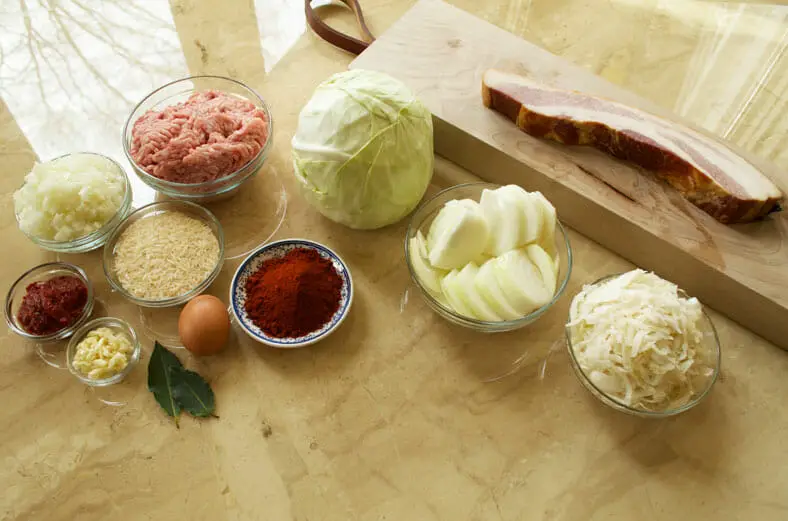
In its current form, toltott kaposzta hybridizes elements of the older world, namely the Magyar bograc and ingredients like pork and cabbage, and infuses it with methods and ingredients from (relatively) more recent times. Ingredients like paprika and rice, as well as the stuffed leaf-wrap method of cooking, are direct takeaways from the Ottoman influence on the region.
Today, toltott kaposzta is everywhere and is perfectly suited for every occasion. Whether it be to cure an unwanted hangover or to celebrating the wedding that might have caused it, toltott kaposzta is tightly woven into the fabric of today’s Hungarian cuisine.
About the Recipe
Thanks to the Turkish influence, the method of preparing the toltott kaposzta is very similar to making dishes like dolmas or yalanci sarma. Except, of course, instead of using grape leaves, you’re using cabbage as the wrapping material.

There are three main phases to bringing your toltott kaposzta to life. First, there’s your cabbage wrappers. If you’re starting with a fresh head of cabbage, you’ll need to quickly core then blanche your head of cabbage to soften and easily peel the leaves for rolling. Some recipes we came across used pre-pickled softened cabbage leaves, but that was something we didn’t come across ourselves.
Next, there’s the filling, which is a combination of rice (also a Turkish influence), ground pork, egg and a healthy amount of paprika.

Once the filling is made and your wrappers ready, you place a bit of filling into the middle of the cabbage leaf and then gently wrap around it. Especially with cabbage leaves, be very careful not to tear them – something we unfortunately learned the hard way.
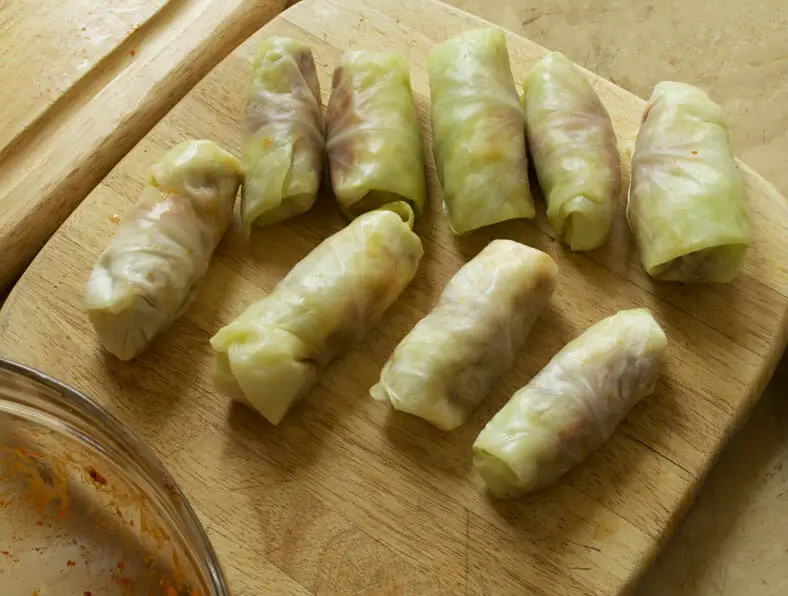
Once wrapped, the toltott kaposzta cooks and simmers in a hearty flavored broth. This broth is commonly flavored with traditional Hungarian ingredients like yellow onions, sauerkraut, smoked bacon, and paprika of course!

Put all together on a slow simmer for at least an hour, you get a toltott kaposzta that is a truly delicious and decadent Hungarian comfort food. Toltott kaposzta is served with a bit of the broth and very commonly with a thick sour cream called tejfol.

Our Take on the Recipe
Going into this, we figured there would have to be a lot of adjustments in order to make a healthier and less “comfort-foody” version of toltott kaposzta.
After coming across recipes like our original reference recipe, we had to make surprisingly little adjustments, but there were still a few to be done.
For starters, we got rid of the lard in our toltott kaposzta. Yes, it’s a very common Hungarian ingredient to have, but it’s hard for us to suggest that this can be made healthy when there’s a whole slew of lard used.
With regards to thickeners both in the toltott kaposzta filling and the broth, we opted to also forego the breadcrumbs and the flour roux, respectively. Instead of using breadcrumbs, we added a little more rice and increased the proportions of dry spices, which simulated the same sort of binding effect as breadcrumbs would have had. We didn’t do anything to replace the roux, which admittedly left the broth less thick.
Finally, when serving the toltott kaposzta, instead of making the traditional tejfol sour cream garnish, we topped our recipe off with full-fat plain yogurt and a sprinkle of paprika.
All in all, the experience of making toltott kaposzta and understanding more about the deeply intertwined Hungarian food culture was an incredible one.
Here’s to Hungary’s coat of arms!
Have you made toltott kaposzta? Comment below!
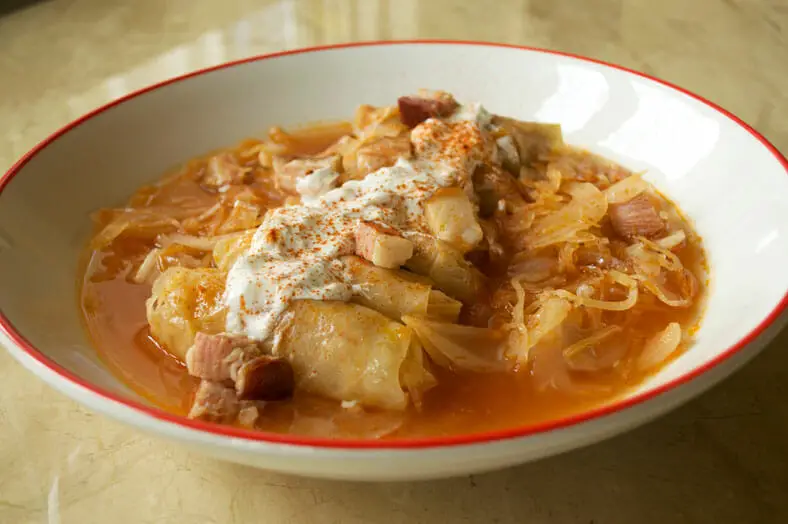

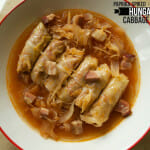
Toltott Kaposzta: Hungarian Stuffed Cabbage Rolls
- Total Time: 1 hour 30 minutes
- Yield: 12–15 rolls 1x
Description
Toltott Kaposzta in ground pork and egg.
Ingredients
- 1 large head cabbage
- 3–4 cups of sauerkraut
- ¼ pound smoked ham or bacon, cut into ½ inch cubes
- 5 cups stock, either beef or vegetable
- 2 large onions, sliced
- 3 tablespoons tomato paste
- 1 tablespoon salt
- 2 bay leaves
- Yogurt for garnish
Filling
- 1 pound ground pork
- ½ cup pre-cooked long-grain rice
- 1 large egg
- 1 onion, minced very finely
- 4–5 cloves of garlic, minced
- 1 teaspoon freshly ground black pepper
- 4 tablespoons paprika
Instructions
Stage 1: Boil Cabbage
- Set a large stockpot ¾ full of water onto your stove above high heat and bring to a boil
- Core your head of cabbage at its bottom and place into the boiling water. Let it boil for 5 minutes
- Once 5 minutes is up, remove the cabbage and dunk into a bowl of ice water to “shock” it to stop it from cooking
- Remove it from the bucket of ice water and set it aside in a bowl to let it drain of water.
- Take your stockpot, drain of water, and set aside
Stage 2: Mix Filling
- In a large bowl, mix your rice, ground pork, onion, garlic and egg together (it’s easiest to do this with your hands, but that’s up to you)
- Once everything has been mixed, add your black pepper and paprika and mix again until spices are evenly distributed
Stage 3: Peel Cabbage Leaves, Add Filling and Roll
- Once the cabbage is more dry, begin peeling leaves off the cabbage. Be very careful not to rip the leaves so your rolling can be done more easily
- Place one cabbage leaf on a flat surface like a cutting board. Cut and remove a small part of the spine to flatten the leaf more and make it easier to roll around the filling
- Take a large tablespoonful of filling and place it in the middle of your leaf
- Slowly roll and tighten the cabbage around the filling, folding the sides of the leaf into the middle first, and then rolling the leaf up until it’s wrapped around itself entirely
- Repeat until all cabbage leaves are stuffed and rolled
Stage 4: Layer Cabbage Rolls in Stockpot and Cook
- Take your large stockpot and create a bottom layer of half your coarsely chopped onions and sauerkraut
- Next, layer the cabbage rolls on top of the bottom layer
- Add another layer of your remaining sauerkraut and onions on top of the cabbage rolls
- Add your smoked ham or bacon on top the sauerkraut and onion layer
- Slowly pout your stock into the stockpot, submerging all the ingredients. If your stock doesn’t submerge everything, use water as needed
- Add your bay leaves and tomato paste. Stir the tomato paste into the liquid
- Bring your stockpot and the stock to a boil over high heat, and then reduce to a simmer for 1 hour
- After 1 hour, take the stockpot off the heat and remove the cabbage rolls from the stockpot. Serve your rolls with some of the cooked stock as well as yogurt on top or on the side, and enjoy!
- Prep Time: 30 mins
- Cook Time: 1 hour
- Category: Snacks
- Cuisine: Hungarian
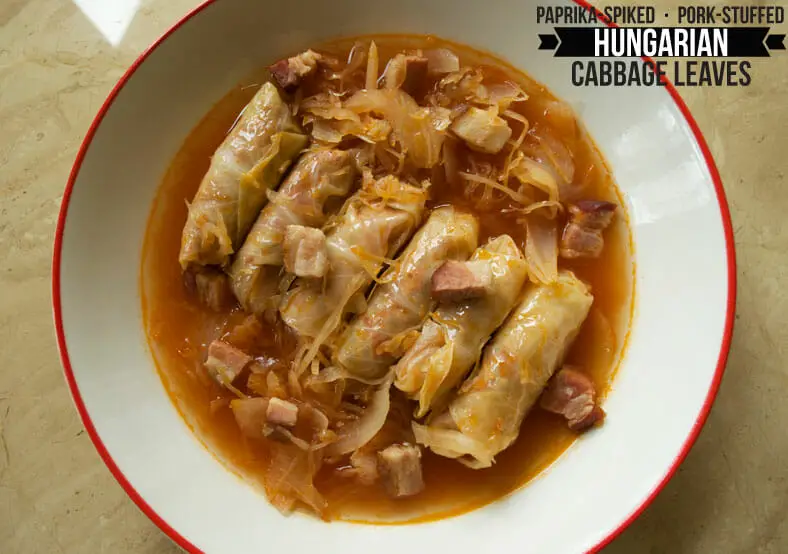
Heather, I was telling Cyrus yesterday that I am loving your blog- The international recipes you guys share is amazing and makes the travel bug in me so happy! This looks delicious- I’ve only tried goulash in terms of Hungarian cuisine!
That’s awesome, Arman! So excited that you’re enjoying the blog… and a little travel bug is good for everyone to have, am I right? If you happen to give this recipe a shot, let us know!
– Heather
I have made stuffed cabbage before but not the Hungarian style and will add this to my to-do list. I think you rolled those cabbages perfectly. What a delicious dish!
Thanks, Manila Spoon! Once you get to it on your to-do, let us know how it goes 🙂
Love your explanation for the influences on Hungary and Hungarian cuisine. In my own family (Eastern European, but not Hungarian), we make stuffed cabbage with ground beef rather than pork and use a tomato base for the broth. This version looks delicious, though, and I have no objection to pork (or bacon), so I’ll have to try it this way. Haven’t made stuffed cabbage in years, but you’ve renewed by interest.
That’s interesting though, Laura, that there seem to be a lot of similarities between your family’s recipe and toltott kaposzta? Where in Eastern Europe is your family from?
If you happen to give this a try, we’d love to know how it compares to the version you’re used to 🙂
I agree those cabbages are rolled perfectly. I never knew so much about Hungary. Looks very flavorful.
Thanks, Twisted Tastes! If you happen to give it a try, let us know!